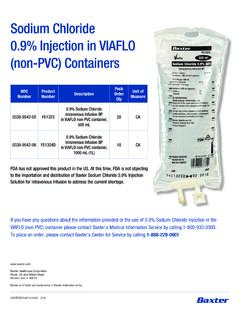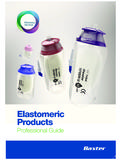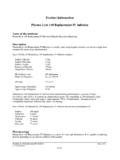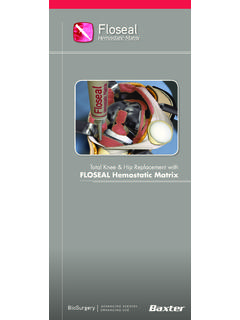Transcription of Floseal Hemostatic Matrix ENG - Baxter BioSurgery
1 Floseal Hemostatic Matrix ENG. Instructions for Use DO NOT INJECT INTRAVASCULARLY. Floseal Hemostatic Matrix ( Floseal ) must not be injected into blood vessels. Short Instruction: 1. Apply Floseal directly to the source of bleeding. 2. Maintain Floseal at the site (source of bleeding) for 2 minutes with gentle approximation. 3. Use adequate amounts of Floseal to completely cover the tissue defect. 4. Work quickly. 5. Always irrigate excess Floseal away. Use gentle irrigation Device Description The Floseal kit consists of a bovine-derived Gelatin Matrix , a human derived Thrombin Component, Applicator tips, and several mixing accessories. The mixing accessories include a syringe with an integral female Luer connector attached, a small bowl, and a 5 mL syringe with needle attached. The mixing accessories are included to facilitate the reconstitution and mixing of the thrombin into the Gelatin Matrix .
2 Applicator tips are included to facilitate the delivery of Floseal to the site to be treated. (For specific kit contents, see Table in How Supplied section.). The Gelatin Matrix , manufactured by Baxter Healthcare Corporation, consists of crosslinked gelatin granules and is provided sterile and non-pyrogenic in a standard disposable syringe. The Thrombin (Human) is a sterile, non-pyrogenic, freeze-dried, vapor-heated and solvent detergent-treated powder preparation made from pooled human plasma. The Calcium Chloride Solution is a sterile, non-pyrogenic solution. After reconstitution of the lyophilized Thrombin in Calcium Chloride Solution, the resulting thrombin solution contains 500 IU/mL Thrombin (Human). Floseal is a combination of the Gelatin Matrix and the Thrombin Component. Thrombin must be added to the Gelatin Matrix prior to use. Floseal is biocompatible and resorbed within 6 to 8 weeks, consistent with normal wound healing.
3 How Supplied Floseal is provided in the configuration shown in the table below. Floseal Hemostatic Matrix Kit Configuration Gelatin Matrix Component Thrombin Component 1 x 5 mL syringe with Gelatin 1 x 2,500 IU/vial Human Matrix Thrombin VH S/D. 1 x 5 mL syringe with female Luer 1 x 5 mL vial Calcium Chloride connector solution 1 x bowl for Thrombin solution o 200 mol CaCl2. Applicator tips (2) 1 x 5 mL syringe with needle attached The Gelatin Matrix component of Floseal is sterilized by irradiation. The Thrombin and its Calcium Chloride diluent are processed using aseptic technique, which includes a sterilizing filtration. The thrombin components are then sealed in a double pouch and treated with ethylene oxide to render the external component surfaces suitable for use in the sterile field. Indications Floseal is indicated in surgical procedures as an adjunct to hemostasis when control of bleeding, ranging from oozing to spurting, by ligature or conventional procedures is ineffective or impractical.
4 Contraindications Do not use Floseal in patients with known allergies to materials of bovine origin. Warnings Do not inject or compress Floseal into blood vessels. Do not apply Floseal in the absence of active blood flow, , while the vessel is clamped or bypassed. Extensive intravascular clotting and even death may result. Floseal is not intended as a substitute for meticulous surgical technique and the proper application of ligatures or other conventional procedures for hemostasis. Floseal is not intended to be used as a prophylactic Hemostatic agent to prevent postoperative bleeding. Excess Floseal Matrix (material not incorporated in the Hemostatic clot) should always be removed by gentle irrigation from the site of application. Meticulous irrigation is required when used in, around, or in proximity to foramina in bone, areas of bony confine, the spinal cord, the brain and/or cranial nerves.
5 As with any implantable material, the use of Floseal is not recommended in the presence of an active infection. Floseal should be used with caution in contaminated areas of the body. If signs of infection or abscess develop where Floseal has been applied, re- operation may be necessary in order to remove the infected material and allow drainage. Floseal swell volume is between 10-20% after product is applied and its potential effect on the surrounding anatomic areas. Maximum swell volume is achieved within about 10 minutes. The safety and effectiveness of Floseal for use in ophthalmic procedures has not been established. Floseal should not be used for controlling intrauterine post-partum bleeding or menorrhagia. The safety and effectiveness of Floseal has not been established in children and pregnant women. Floseal contains Gelatin of bovine origin. The risk with respect to Transmissible Spongiform Encephalopathies (TSE) has been minimized in accordance with regulatory guidelines by a manufacturing process with demonstrated TSE inactivation capacity.
6 Floseal also contains Thrombin made from human plasma. When medicines are made from human blood and plasma, certain measures are put in place to prevent infections being passed on to patients. These include careful selection of blood and plasma donors to make sure those at risk of carrying infections are excluded, and the testing of each donation and pools of plasma for signs of virus/infections. Manufacturers of these products also include steps in the processing of the blood or plasma that can inactivate or remove viruses. Despite these measures, when medicines prepared from human blood or plasma are administered, the possibility of passing on infection cannot be totally excluded. This also applies to any unknown or emerging viruses or other types of infections. The measures taken are considered effective for enveloped viruses such as human immunodeficiency virus (HIV), hepatitis B. virus and hepatitis C virus, and for the non-enveloped hepatitis A and parvovirus B19V viruses.
7 AII infections thought by a physician possibly to have been transmitted by this product should be reported by the physician or other healthcare provider to Baxter Healthcare Corporation. The physician should discuss the risks and benefits of this product with the patient. Precautions For single use only. Do not resterilize. As with other Hemostatic agents, circumstances that result in a negative peripheral venous pressure ( patient positioning) may draw material into the vascular system, potentially resulting in life-threatening thromboembolic events. When placed into cavities or closed tissue spaces, gentle approximation is advised. When applied to a bleeding site, the particles of Floseal Matrix swell approximately 20% upon contact with blood or other fluids. Maximum swell volume is achieved within about 10 minutes. As with other Hemostatic agents, do not allow Floseal to enter into cell saver equipment, extracorporeal cardiopulmonary bypass circuits or autologous blood salvage circuits.
8 It has been demonstrated that fragments of collagen based Hemostatic agents may pass through 40 m transfusion filters of blood scavenging systems. Do not use Floseal on bone surfaces where adhesives, such as methylmethacrylate or other acrylic adhesives, will be required to attach a prosthetic device. Microfibrillar collagen has been reported to reduce the strength of methylmethacrylate adhesives used to attach prosthetic devices to bone surfaces. Do not use Floseal in the closure of skin incisions because it may interfere with the healing of the skin edges due to mechanical interposition of gelatin. The safety and effectiveness of the use of Floseal Matrix as a carrier for antibiotic solutions or powders has not been established. The Thrombin Solution can be denatured by contact with solutions containing alcohol, iodine, or heavy metal ions. If antiseptics containing such substances have been used near the site of bleeding, Floseal Matrix should not be applied until after the application site is cleaned to remove any such substances.
9 Adverse Events In a randomized prospective, concurrently controlled clinical trial using a formulation of Floseal Gelatin Matrix containing bovine thrombin, ( Floseal ), a total of 309 patients received Floseal or the Control (Gelatin Sponge +. Thrombin). The most common adverse events recorded during and after the application of the Hemostatic agents were anemia, atrial fibrillation, infection, and hemorrhage. The following is a complete list of adverse events reported in greater than 1% of patients that were observed in the pivotal clinical trial for the Floseal group. The corresponding adverse events for the Control group are listed for comparison. None of the adverse events that occurred were judged by the surgeon to be Probably Related to the use of Floseal . Adverse Events Reported in Greater than 1% of Patients in the Floseal Clinical Trial Patients Adverse Event Floseal Control (Gelatin Sponge +.)
10 Thrombin). Anemia 12 (8%) 7 (4%). Fibrillation Atrial 10 (6%) 8 (5%). Infection 10 (6%) 11 (7%). Hemorrhage 6 (4%) 6 (4%). Pneumonia 6 (4%) 2 (1%). Urinary Tract Infection 6 (4%) 3 (2%). Rash 5 (3%) 3 (2%). Edema 5 (3%) 1 (<1%). Hypotension 4 (3%) 2 (1%). Respiratory Distress 4 (3%) 3 (2%). Confusion 4 (3%) 0 (0%). Dural Tear 4 (3%) 4 (3%). Fibrillation Ventricular 4 (3%) 3 (2%). Arrhythmia 4 (3%) 0 (0%). Heart Failure Right 3 (2%) 2 (1%). Thrombosis Arterial 3 (2%) 8 (5%). Fever 3 (2%) 2 (1%). Atelectasis 3 (2%) 1 (<1%). Pleural Effusion 3 (2%) 5 (3%). Counts reflect number of patients in each treatment group reporting one or more adverse events that map to a Modified COSTART 5th edition body system. At each level of summarization (Adverse Event), patients are only counted once. Other adverse events observed in 1% or less of the Floseal clinical trial patients were myocardial infarction, cellulitis, pneumothorax, pain, cerebrovascular accident, hallucination, paraesthesia, bradycardia, abscess, diarrhea, urinary retention, dehiscence, skin ulcer, transfusion reaction, dyspnea, heart arrest, lung edema, back pain, ventricular tachycardia, neuropathy, acute kidney failure, kidney tubule necrosis, gastritis, nausea, nausea and vomiting, skin rash, hyperglycemia, and heel ulcer.







